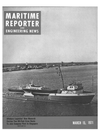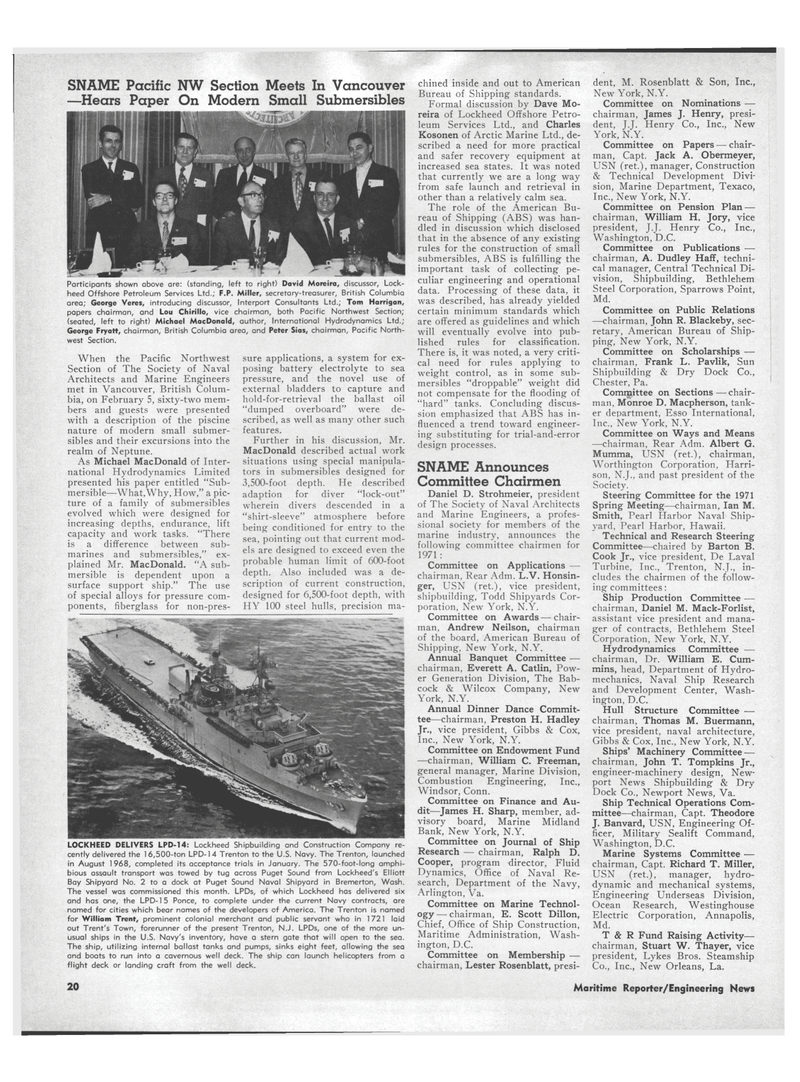
Page 18: of Maritime Reporter Magazine (March 15, 1971)
Read this page in Pdf, Flash or Html5 edition of March 15, 1971 Maritime Reporter Magazine
SNAME Pacific NW
When the Pacific Northwest
Section of The Society of Naval
Architects and Marine Engineers met in Vancouver, British Colum- bia, on February 5, sixty-two mem- bers and guests were presented with a description of the piscine nature of modern small submer- sibles and their excursions into the realm of Neptune.
As Michael MacDonald of Inter- national Hydrodynamics Limited presented his paper entitled "Sub- mersible—What,Why, How," a pic- ture of a family of submersibles evolved which were designed for increasing depths, endurance, lift capacity and work tasks. "There is a difference between sub- marines and submersibles," ex- plained Mr. MacDonald. "A sub- mersible is dependent upon a surface support ship." The use of special alloys for pressure com- ponents, fiberglass for non-pres-
Meets In Vancouver sure applications, a system for ex- posing battery electrolyte to sea pressure, and the novel use of external bladders to capture and hold-for-retrieval the ballast oil "dumped overboard" were de- scribed, as well as many other such features.
Further in his discussion, Mr.
MacDonald described actual work situations using special manipula- tors in submersibles designed for 3,500-foot depth. He described adaption for diver "lock-out" wherein divers descended in a "shirt-sleeve" atmosphere before being conditioned for entry to the sea, pointing out that current mod- els are designed to exceed even the probable human limit of 600-foot depth. Also included was a de- scription of current construction, designed for 6,500-foot depth, with
HY 100 steel hulls, precision ma- chined inside and out to American
Bureau of Shipping standards.
Formal discussion by Dave Mo- reira of Lockheed Offshore Petro- leum Services Ltd., and Charles
Kosonen of Arctic Marine Ltd., de- scribed a need for more practical and safer recovery equipment at increased sea states. It was noted that currently we are a long way from safe launch and retrieval in other than a relatively calm sea.
The role of the American Bu- reau of Shipping (ABS) was han- dled in discussion which disclosed that in the absence of any existing rules for the construction of small submersibles, ABS is fulfilling the important task of collecting pe- culiar engineering and operational data. Processing of these data, it was described, has already yielded certain minimum standards which are offered as guidelines and which will eventually evolve into pub- lished rules for classification.
There is, it was noted, a very criti- cal need for rules applying to weight control, as in some sub- mersibles "droppable" weight did not compensate for the flooding of "hard" tanks. Concluding discus- sion emphasized that ABS has in- fluenced a trend toward engineer- ing substituting for trial-and-error design processes.
SNAME Announces
Committee Chairmen
Daniel D. Strohmeier, president of The Society of Naval Architects and Marine Engineers, a profes- sional society for members of the marine industry, announces the following committee chairmen for 1971 :
Committee on Applications — chairman, Rear Adm. L.V. Honsin- ger, USN (ret.), vice president, shipbuilding, Todd Shipyards Cor- poration, New York, N.Y.
Committee on Awards — chair- man, Andrew Neilson, chairman of the board, American Bureau of
Shipping, New York, N.Y.
Annual Banquet Committee — chairman, Everett A. Catlin, Pow- er Generation Division, The Bab- cock & Wilcox Company, New
York, N.Y.
Annual Dinner Dance Commit- tee—chairman, Preston H. Hadley
Jr., vice president, Gibbs & Cox,
Inc., New York, N.Y.
Committee on Endowment Fund —chairman, William C. Freeman, general manager, Marine Division,
Combustion Engineering, Inc.,
Windsor, Conn.
Committee on Finance and Au- dit—James H. Sharp, member, ad- visory board, Marine Midland
Bank, New York, N.Y.
Committee on Journal of Ship
Research — chairman, Ralph D.
Cooper, program director, Fluid
Dynamics, Office of Naval Re- search, Department of the Navy,
Arlington, Va.
Committee on Marine Technol- ogy— chairman, E. Scott Dillon,
Chief, Office of Ship Construction,
Maritime Administration, Wash- ington, D.C.
Committee on Membership — chairman, Lester Rosenblatt, presi- dent, M. Rosenblatt & Son, Inc.,
New York, N.Y.
Committee on Nominations — chairman, James J. Henry, presi- dent, J.J. Henry Co., Inc., New
York, N.Y.
Committee on Papers — chair- man, Capt. Jack A. Obermeyer,
USN (ret.), manager, Construction & Technical Development Divi- sion, Marine Department, Texaco,
Inc., New York, N.Y.
Committee on Pension Plan — chairman, William H. Jory, vice president, J.J. Henry Co., Inc.,
Washington, D.C.
Committee on Publications — chairman, A. Dudley Haff, techni- cal manager, Central Technical Di- vision, Shipbuilding, Bethlehem
Steel Corporation, Sparrows Point,
Md.
Committee on Public Relations —chairman, John R. Blackeby, sec- retary, American Bureau of Ship- ping, New York, N.Y.
Committee on Scholarships — chairman, Frank L. Pavlik, Sun
Shipbuilding & Dry Dock Co.,
Chester, Pa.
Comrjiittee on Sections —chair- man, Monroe D. Macpherson, tank- er department, Esso International,
Inc., New York, N.Y.
Committee on Ways and Means —chairman, Rear Adm. Albert G.
Mumma, USN (ret.), chairman,
Worthington Corporation. Harri- son, N.J., and past president of the
Society.
Steering Committee for the 1971
Spring Meeting—chairman, Ian M.
Smith, Pearl Harbor Naval Ship- yard, Pearl Harbor, Hawaii.
Technical and Research Steering
Committee—chaired by Barton B.
Cook Jr., vice president, De Laval
Turbine, Inc., Trenton, N.J., in- cludes the chairmen of the follow- ing committees:
Ship Production Committee — chairman, Daniel M. Mack-Forlist, assistant vice president and mana- ger of contracts, Bethlehem Steel
Corporation, New York, N.Y.
Hydrodynamics Committee — chairman, Dr. William E. Cum- mins, head, Department of Hydro- mechanics, Naval Ship Research and Development Center, Wash- ington, D.C.
Hull Structure Committee — chairman, Thomas M. Buermann, vice president, naval architecture,
Gibbs & Cox, Inc., New York, N.Y.
Ships' Machinery Committee — chairman, John T. Tompkins Jr., engineer-machinery design, New- port News Shipbuilding & Dry
Dock Co., Newport News, Va.
Ship Technical Operations Com- mittee—chairman, Capt. Theodore
J. Banvard, USN, Engineering Of- ficer, Military Sealift Command,
Washington, D.C.
Marine Systems Committee — chairman, Capt. Richard T. Miller,
USN (ret.), manager, hydro- dynamic and mechanical systems,
Engineering Underseas Division,
Ocean Research, Westinghouse
Electric Corporation, Annapolis,
Md.
T & R Fund Raising Activity— chairman, Stuart W. Thayer, vice president, Lykes Bros. Steamship
Co., Inc., New Orleans, La.
LOCKHEED DELIVERS LPD-14: Lockheed Shipbuilding and Construction Company re- cently delivered the 16,500-ton LPD-14 Trenton to the U.S. Navy. The Trenton, launched in August 1968, completed its acceptance trials in January. The 570-foot-long amphi- bious assault transport was towed by tug across Puget Sound from Lockheed's Elliott
Bay Shipyard No. 2 to a dock at Puget Sound Naval Shipyard in Bremerton, Wash.
The vessel was commissioned this month. LPDs, of which Lockheed has delivered six and has one, the LPD-15 Ponce, to complete under the current Navy contracts, are named for cities which bear names of the developers of America. The Trenton is named for William Trent, prominent colonial merchant and public servant who in 1721 laid out Trent's Town, forerunner of the present Trenton, N.J. LPDs, one of the more un- usual ships in the U.S. Navy's inventory, have a stern gate that will open to the sea.
The ship, utilizing internal ballast tanks and pumps, sinks eight feet, allowing the sea and boats to run into a cavernous well deck. The ship can launch helicopters from a flight deck or landing craft from the well deck.
Participants shown above are: (standing, left to right) David Moreira, discussor, Lock- heed Offshore Petroleum Services Ltd.; F.P. Miller, secretary-treasurer, British Columbia area; George Veres, introducing discussor, Interport Consultants Ltd.; Tom Harrigan, papers chairman, and Lou Chirillo, vice chairman, both Pacific Northwest Section; (seated, left to right) Michael MacDonald, author, International Hydrodynamics Ltd.;
George Fryatt, chairman, British Columbia area, and Peter Sias, chairman, Pacific North- west Section. 20 Maritime Reporter/Engineering News

 17
17

 19
19
